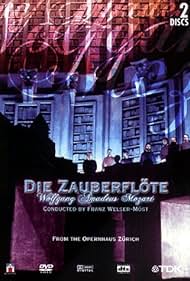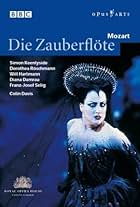Photos
- Director
- Writer
- All cast & crew
- Production, box office & more at IMDbPro
Storyline
Did you know
- ConnectionsVersion of Trollfossen (1948)
Featured review
Freemasonry today may evoke an image of silly men with their trouser-legs rolled up giving funny handshakes. It was not always thus: in Mozart's day it was an important movement promoting, liberty, equality, democracy and republicanism, ideas that were not particularly popular at the time. This is why Mozart, and his librettist Schikaneder, were so keen to produce an opera extolling the virtues of masonry. For that reason, the plot of the opera can sometimes seem tedious, and it is not helped by Mozart's sexism and racism. However the opera contains some of the most sublime music ever written and it can be wonderfully funny and visually spectacular.
Jonathan Miller is one of the few directors who can successfully impose his own concept on an opera and make us see it in a new light. He does so in this version of the Magic Flute, which he stage directed for Zurich Opera. During the overture we see Tamino waiting outside a Masonic temple. He falls asleep and the implication is that the entire opera is the dream of this young man waiting to be inducted into the masonry. Miller confronts Mozart's sexism head-on.. The opera usually starts with Tamino being chased across the stage by a giant serpent. Miller's version opens with his being confronted by a semi-naked woman with a snake curled around her. The evil serpent is female sexuality and it is the task of the masonry to mortify Tamino's flesh against the temptations of Eve.
Miller confronts Mozart's racism in the same way. There is a Mason-Dixie Monostatus, played by a white man in full Al Jolson make-up wearing a minstrel show costume. The fact that the part is unusually beautifully sung by Volker Vogel does not make us feel less uncomfortable.
Miller passes lightly over the Masonic ritual elements in the plot, making the opera about 20 minutes shorter than its usual length, although I could not spot any obvious cuts in dialogue or music. He also plays down the religious aspects, as befits a good atheist. Sadly, he also cuts out most of the magic: the Three Boys do not sail through the air and the Three Ladies look like Calvinist housewives. However, the boys are unusually tuneful and the ladies are delightfully mellifluous. The rest of the cast is up to Zurich's usual high standards. Papageno is played by Anton Scharinger as an uncomplicated but reasonable person, rather than the usual clown. Piotr Beczala is a rather stuffy Tamino and Malin Hartelius is a fragrant Pamina. Matti Salminen is a sonorous Sarastro. Elena Mosuc makes the Queen of the Night's stratospheric arias seem effortless.
This is a coherent, austere Zauberflöte, and, on the whole, it is successful. It is such an unusual reading that, if you only ever saw one Magic Flute, you would not want it to be this one. But, if you know the work well, this is a refreshingly different and stimulating interpretation.
Jonathan Miller is one of the few directors who can successfully impose his own concept on an opera and make us see it in a new light. He does so in this version of the Magic Flute, which he stage directed for Zurich Opera. During the overture we see Tamino waiting outside a Masonic temple. He falls asleep and the implication is that the entire opera is the dream of this young man waiting to be inducted into the masonry. Miller confronts Mozart's sexism head-on.. The opera usually starts with Tamino being chased across the stage by a giant serpent. Miller's version opens with his being confronted by a semi-naked woman with a snake curled around her. The evil serpent is female sexuality and it is the task of the masonry to mortify Tamino's flesh against the temptations of Eve.
Miller confronts Mozart's racism in the same way. There is a Mason-Dixie Monostatus, played by a white man in full Al Jolson make-up wearing a minstrel show costume. The fact that the part is unusually beautifully sung by Volker Vogel does not make us feel less uncomfortable.
Miller passes lightly over the Masonic ritual elements in the plot, making the opera about 20 minutes shorter than its usual length, although I could not spot any obvious cuts in dialogue or music. He also plays down the religious aspects, as befits a good atheist. Sadly, he also cuts out most of the magic: the Three Boys do not sail through the air and the Three Ladies look like Calvinist housewives. However, the boys are unusually tuneful and the ladies are delightfully mellifluous. The rest of the cast is up to Zurich's usual high standards. Papageno is played by Anton Scharinger as an uncomplicated but reasonable person, rather than the usual clown. Piotr Beczala is a rather stuffy Tamino and Malin Hartelius is a fragrant Pamina. Matti Salminen is a sonorous Sarastro. Elena Mosuc makes the Queen of the Night's stratospheric arias seem effortless.
This is a coherent, austere Zauberflöte, and, on the whole, it is successful. It is such an unusual reading that, if you only ever saw one Magic Flute, you would not want it to be this one. But, if you know the work well, this is a refreshingly different and stimulating interpretation.
Details
Contribute to this page
Suggest an edit or add missing content




